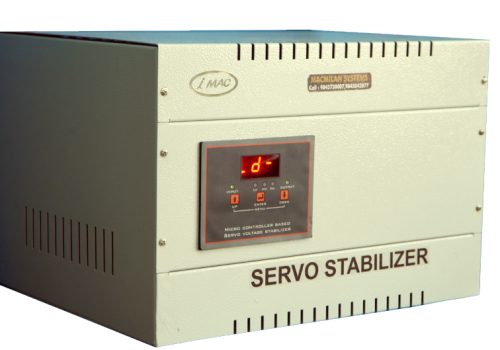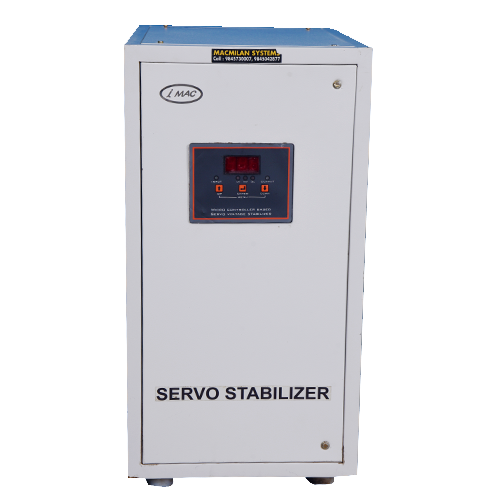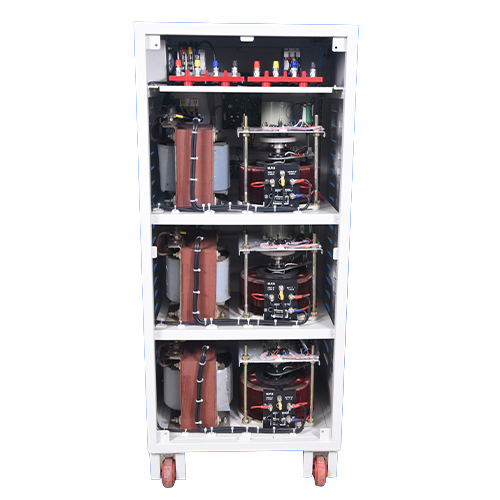
SERVO STABILIZER
Servo stabilizer receives an input current, with fluctuating voltage, the microprocessors in the electronic circuitry triggers the Servo motor driver. This in turn activates the servo motor, which moves across the windings of the auto-transformer. It recognizes the voltage fluctuations in the utility and regulates it internally to deliver a consistent range of output voltage, if your utility voltage is low/high your stabilizer senses it, buckboosts it to the required level of voltage and then feeds to the connected equipment.
APPLICATIONS


Servo Voltage Stabilizers are devices that maintain a constant voltage despite fluctuations in the input voltage. They are used in a variety of industries to protect sensitive equipment from damage caused by power surges. There are two main types of servo stabilizers: Air-Cooled and Oil-Cooled.
Air-cooled servo stabilizers are used for lower capacitoes less load than oil-cooled stabilizers and require less maintenance. However, they are not as effective at regulating voltage as oil-cooled stabilizers and may overheat in high-temperature or high load environments.
Oil-cooled servo stabilizers are more expensive than air-cooled stabilizers, but they are more effective at regulating voltage and can withstand higher loads temperatures without overheating. They require more maintenance than air-cooled stabilizers, however, as the oil needs to be changed periodically.
PROS AND CONS OF EACH TYPE OF SERVO STABILIZERS
Servo Voltage Stabilizers are devices that maintain a constant voltage despite fluctuations in the input voltage. They are used in a variety of industries to protect sensitive equipment from damage caused by power surges. There are two main types of servo stabilizers: air-cooled and oil-cooled.
Air-cooled servo stabilizers are used for lower capacities less load than oil-cooled stabilizers and require more maintenance. However, they are not as effective at regulating voltage as oil-cooled stabilizers and may overheat in high-temperature or high load environments.
Oil-cooled servo stabilizers are more expensive than air-cooled stabilizers, but they are more effective at regulating voltage and can withstand higher loads temperatures without overheating. They require less maintenance and is more rugged than air-cooled stabilizers, however, as the oil needs to be changed periodically.
TECHNICAL DATA SHEET
98 – 99% efficiency (achieved by optimum design & by use of imported hi-quality CRGO laminations & copper of 99.9% purity)
- Immune to load PF & supply frequency variations, Power loss 2% max
- Duty cycle continuou, Life expectancy – 20 – 25 years
Easy & simple maintenance (with plug-in PCBs), Protections – over voltage / under voltage / overload / single phasing
Considerable short time overload capacity, Output voltage setting (by Digital Micro Controller Card in Auto Mode & by ‘Raise’ / ‘Lower’ Push Button in Manual Mode)
- Operation – Auto or Manual,Digital Display Indications for Input Voltage ‘High’ / ‘Low’. Metering (Analogue or Digital) – AC voltmeter with / without selector switch
Non-standard requirements can be catered to, such as AC Ammeter, Frequency Meter, Phase Sequence Meter, Single Phasing Preventer, Stabilizer by-pass arrangement, etc, very high reliability


